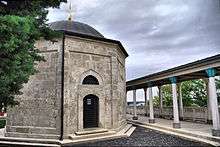Tomb of Gül Baba

Gül Baba's octagonal tomb (türbe) is located on Mecset (mosque) Street, Budapest, a short but steep walk from the Margaret Bridge in the district of Rózsadomb.
History
The tomb was built by Mehmed Paşa, beylerbeyi of Buda,[1] between 1543 and 1548 and has a shallow dome covered with lead plates and wooden tiles.[2] It was left undamaged when the Habsburg armies captured the area during the Second Battle of Buda in 1686, but was converted into a Roman Catholic chapel by the Jesuits, who renamed it "St Joseph's Chapel".

The tomb, in 1916, represented the farthest influence of Bektashism in the Austro-Hungarian Empire.[3] In 1987, in the precinct of the tomb building, the Hungarian government financed the building of an Islamic Centre and Mosque complete with a library and museum. The buildings were designed by Dr. Basil Al Bayati and follow a traditional Ottoman style in their plan.[4]
"Dr. Bayati’s design presents a large complex which successfully combines the styles of Ottoman architecture (as it was practised in Eastern Europe) and Hungarian architecture in the style of Lechner. The platform on which this complex is envisaged is already standing. The new buildings flank the turbe to the right and left. The building to the left, or more precisely to the south of the turbe, is a mosque. This is covered by three domes, all resting on drums of various heights, that in the centre being taller than the lateral ones. Due to the cold climate of the country the mosque is entirely covered and is rectangular in shape. Since colour is very much in evidence both on the exterior and interior of the building, it is envisaged that the mihrab will be coated with Zsolnay tiles and framed by a rectangular border containing Quranic inscription.”[5]

Ownership
The land later came under the ownership of János Wagner, who maintained the site and allowed access to Muslim pilgrims coming from the Ottoman Empire (see Islam in Hungary). In 1885, the Ottoman government commissioned a Hungarian engineer to restore the tomb and, when work was completed in 1914, it was declared a national monument. The site was restored again in the 1960s and ultimately in 1987 when an Islamic Centre and Mosque were built surrounding it.[4] It is now the property of the Republic of Turkey.
Gallery
See also
References
- ↑ Muslim Cultural Enclaves in Hungary under Ottoman Rule, Gabor Ágoston, Acta Orientalia Academiae Scientiarum Hungaricae, T. 45, Fasc. 2/3 (1991), 197.
- ↑ Andrew Peterson, Hungary, Dictionary of Islamic Architecture, (London: Routledge, 1996), 112. ISBN 0-415-06084-2.
- ↑ Geographical Distribution of the Bektashi, F. W. Hasluck, The Annual of the British School at Athens, Vol. 21, (1914/1915 - 1915/1916), 122.
- 1 2 Al Bayati, Basil (1988). Architect. London: Academy Editions/St. Martin's Press. p. 228. ISBN 0-85670-925-5.
- ↑ Fehervari, Geza (11 May 1990). "Back to Budapest". Building Design magazine. p. 35.
External links
| Wikimedia Commons has media related to Tomb of Gül Baba. |
- Gül Baba Shrine by the Turkish Ministry of Culture
- Gül Baba Tomb in Budapest
- Basil Al Bayati Official Website of Architect
Coordinates: 47°30′57.45″N 19°2′5.7″E / 47.5159583°N 19.034917°E



..jpg)